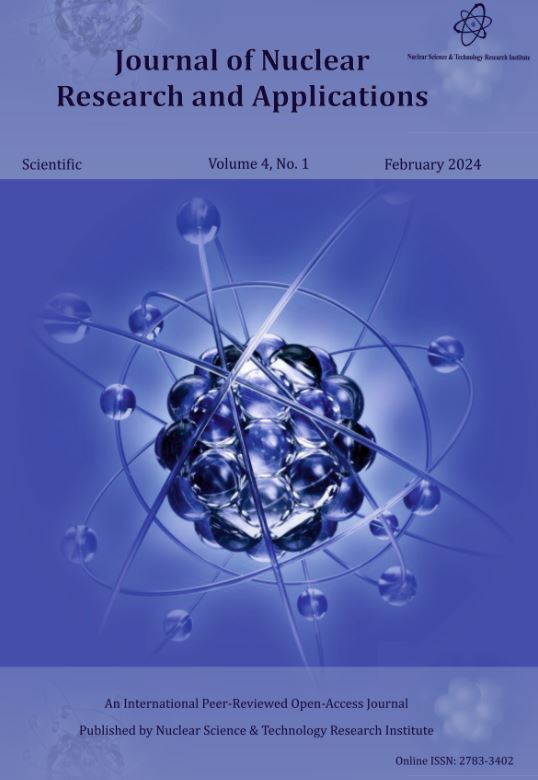Document Type : Technical Paper
Authors
1 Radiation Application Research School, Nuclear Science and Technology Research Institute, , P. O. Box: 11365-3486, Tehran, Iran
2 Faculty of Advanced Science & Technologies, University of Isfahan, P. O. Box: 8174673441, Isfahan, Iran
Abstract
A portable body counter detects internal contamination in an emergency. Monte Carlo code estimates minimum detection activity (MDA) for a portable whole-body counter. In the case of outdoor open fields, natural background radiations were simulated. This counter has a chair geometry equipped with a NaI (Tl) detector (5cm x 5cm) inside a lead shield collimator consisting of a set of lines and a continuous component with monenergistic γ sources ranging from 300 to 2000 keV at intervals of 100 keV. This data matrix is folded with the measured spectrum outside the setup to estimate the observed spectrum in the detector. We evaluated the variation of the detector flux transmitted through the lead collimator and chair shield. This was done at different lead densities and different photon energies. Computational data were used to estimate the monitoring system MDA. This method is cheaper to design and test a counter system for low-level counting of γ emitting radionuclides than experimental methods
Keywords
Main Subjects
- 1. Mizushita S. Portable Chair Type Whole-Body Counter. Nucl Sci Technol. 1977;14:911-915.
- Shagina NB, Bougrov NG, Degteva MO, Kozheurov VP, Tolstykh EI. An Application of Invivo Whole Body Counting Technique for Studying Strontium Metabolism and Internal Dose Reconstruction for the Techa River Population. Phys Conf Ser. 2006;41:433–440.
- Mizushita S. New Chair type Whole-body Counter. J. Nucl Sci Technol. 1989;26:278-285.
- Ishikawa T, Matsumoto M, Uchiyama M. A Calibration Method for Whole-body ounters, Using Monte Carlo simulation. Radiat Prot Res. 1996;64:283-288.
- Bento J, Barros S, Teles P, Neves M, Gonçalves I, Corisco J, Vaz P. Monte Carlo Simulation of the Movement and Detectable Efficiency of a Whole Body Counting System Using a BOMAB Phantom. Radiat Prot Res. 2012;148:403–413.
- Shi H, Chen B, Li T, Yun D. Precise Monte Carlo Simulation of Gamma-ray Response Functions for a NaI (Tl) Detector. Appl Radiat Isot. 2002;5:517-524.
- Kim J, Lee B, Choi H, Lim Y. Efficiency Calibration of Bed Type Whole-body Counter Using Monte Carlo Simulations and Application to Intake Estimation of 131I. J. Nucl Sci Technol, 2011;1:549-551.
- Gouda MM, Badawi MS, El-Khatib AM, Hussien N. Calculation of NaI (TI) Detector Full-Energy Peak Efficiency using the efficiency transfer method for Small radioactive cylindrical Source. Nucl Technol Radiat Prot. 2013; 31:150-158.
- Schlagbauer M, Hrnecek E, Rollet S, Fischer H, Brandl A, Kindlet P. Uncertainty Budget for a Whole-body Counter in the Scan Geometry and
Computer Simulation of the Calibration Phantoms. Radiat Prot Dos. 2007;125:149-52.
- Ören Ü, Andersson M, Rääf C, Mattsson S. A phantom for determination of calibration coefficients and minimum detectable activities using a dual-head gamma camera for internal contamination monitoring following radiation emergency situations. Radiat. Prot. Dosim. 2016; 169: 297–302.
- Díaz-Londoño G, García M, Astudillo R, Hermosilla A. Development and implementation of tools for self-monitoring of staff exposed to 131I in nuclear medicine centres of Chile. Radiat. Prot. Dosim. 2017. 173 (4), 302–307.
- Medici S, Desorgher L, Carbonez P, Damet
J, Bochud F, Pitzschke A, Impact of the phantom geometry on the evaluation of the minimum detectable activity following a radionuclide intake: From physical to numerical phantoms. Radiat Measur. 2020;139: 106485. - Santos R, Xavier M, Cardoso JCS. Evaluation of The Minimum Detectable Activity of Whole Body and Thyroid Counters at In Vivo Monitoring Laboratory of IPEN/CNEN-SP. International Nuclear Atlantic Conference –INAC, 2011.
- Mitra MS, Sarkar PK, Monte Carlo Simulations to Estimate the Background Spectrum in a Shielded NaI (Tl) γ-Spectrometric System. Appl Radiat Isot. 2005;63:415-422.
- Estrada JJ, Laurer GR A Method to Obtain Subject Background for Low level In-vivo Measurements of the Head. Health Physics Society. 1993; 306-312.
- Kramer G, Crowley P, Burns LC. Investigating the Impossible: Monte Carlo Simulations. Radiat Prot Dos. 2000; 89:259-262.
- Breustedt B, Eschner W. Monte Carlo Calibration of Whole-body Counters with NaI (Tl) Detectors in Stretcher Geometry. Radiat Prot Dos. 2010;139: 510-518.
- Tariq H, Mirza S, Rehman S, Mirza NM. Stochastic Simulation Study of HPGe Detector Response and the Effect of Detector Aging Using Geant4, Nucl Technol Radiat Prot. 2017;32, 57-69.
- Kinase S, Yoshizawa M, Kuwabara J, Noguchi H. Evaluation of Response of Whole-body counters using the EGS4 Code. Nucl Sci Technol. 1998; 35:958-962.
- Kramer G, Capello K, Ross K, The W-chair Whole Body Counter: a Monte Carlo Investigation. Health Phys. 2005; 88:364-370.
- Lei W, Yi-ni W, Jie P, Jing N, Xin L, Xue-lan Y, Ting Z, Wei L, Xian-guo T. A portable internal contamination monitor with dual detectors for screening in a large-scale radiological incident. Appl Radiat Isot. 2019; 154:108858.
- Poorbaygi H, S Pourali, Mostajabodavati M, Bagheri S , Design and Calibration of a Chair-Type Whole Body Counter. Iranian J. Nucl Sci Technol. 2016;78:18-23.
- Kramer, G, and Capello, K. Calibration of the HML's portable whole body counter as a function of BOMAB phantom size and energy modelled by MCNP. Spain: N. p., 2004. Web.
- Sharma S, Sarkar MS. Measurement and simulation of gamma-ray background in a low energy accelerator facility, J. Instrumen. 2020;:15;1-19.

